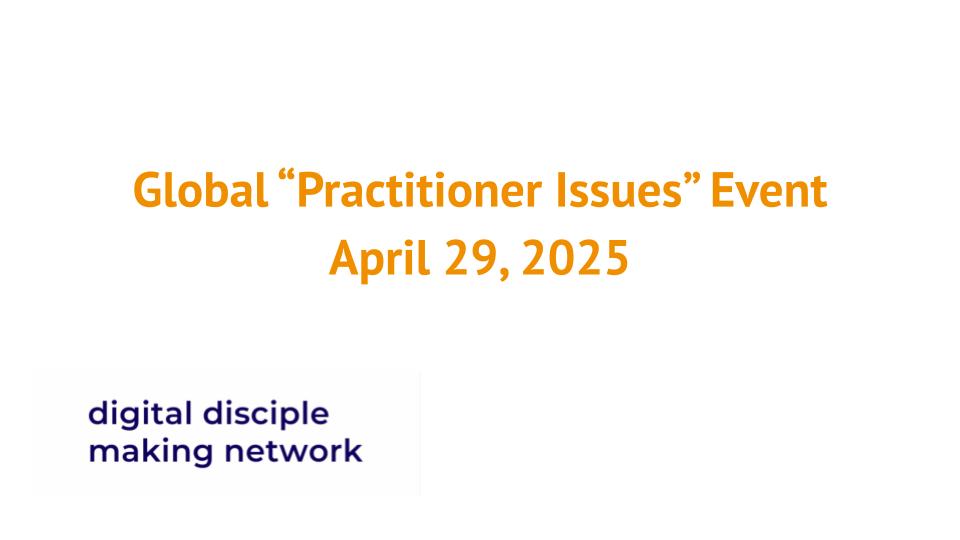
Overview
On April 29, 2025 the Digital Disciple Making Network hosted a global practitioner meet-up with 38 participants on the topic of “Best Practices and Troubleshooting in Partnership Building.” The meeting focused on digital disciple-making partnerships and strategies, with presentations from three team members on the topics of vision alignment, cultural intelligence, and relationship building.
Introduction to Digital Disciple Making Network Slide Deck
The mission of the DDMN is to equip disciple makers to accelerate movements with an end-to-end strategy with an emphasis on least-reached people. The leadership team of the DDMN comes from many different organizations and is made up of people who can provide training, mentoring, and media resources to a broad base of practitioners.
1. Who to Partner With (Amber) Slide Deck (beginning slide 16)
Four filters for effective partnership:
1. Connection: People over projects. “By this shall all men know that you are my disciples, if you have love one for another” John 15:35.
2. Calling: Go slow and evaluate regularly.
3. Clarity of Mission: Measure what matters–both qualitatively and quantitatively.
4. Commitment: Partnership is an investment. It should be appropriately discerned and not entered into lightly.
Resources Offered:
* MOU/Partnership Multiplier Agreement Template
* Movement Network manual for onboarding new partners
* Presentation notes
2. Facilitating a Country-wide Partnership (LT) Slide Deck
LT gave a case study of a country-wide strategy focusing on a specific UPG using multiple platforms.
Mistakes:
1. “What’s in it for me?” attitude.
2. The decision-making process was vision driven, not people driven.
3. Focusing on differences vs. commonalities.
What efforts are required to sustain?
1. Trust & relationship.
2. Sacrifice & service.
3. “Are you the judge?” attitude. Different contexts may need different practices.
4. Embrace collaborative success. 1 Corinthians 12: In Christ, we are one body with many parts.
3: The Benefits and Challenges of Cross-cultural Partnerships (David Yambua) Slide Deck
Benefits:
1. Deeper creativity, innovation, and endurance.
“Two are better than one, because they have a good return for their labor. For if one falls down, his companion can lift him up; but pity the one who falls without another to help him up!” Ecclesiastes 4:9-10.
2. Wider reach and mutual learning.
“Five of you shall chase a hundred and a hundred of you shall chase ten thousand” Leviticus 26:8.
3. Resource sharing: sharing of funds, tools, training, local case studies, networks, and wisdom.
Challenges:
1. Communication misfires.
2. “Can two people walk together without agreeing on the direction?” Amos 3:3.
Unequal expectations and pace.
Practical Next Steps:
1. Partnerships grounded in scripture.
2. Cultural intelligence: Cultural Intelligence drive, knowledge, strategy, and action.
There are values beyond output:
1. Celebrate relationships and cultural insights as equally valuable.
Question and Answer
* One commenter added that the objective of partnerships should be to accomplish something together, not just to increase the number of people involved.
* David was asked, “How can I identify a person on a team with cultural intelligence?” Answer: through building a relationship and understanding the person’s preparedness and experience with different cultures.
* Two participants expressed their thoughts on the importance of alignment and the challenges of clarifying the vision.
* One shared his experience of organizing a clear vision and mission statement to help churches understand their purpose. He emphasized the importance of revisiting the vision and values regularly to ensure alignment.
* The presenters discussed the importance of existing networks and cultural intelligence in identifying potential partners and emphasized the role of humility and bridge-building in cross-cultural partnerships.
* What roles do MOUs play in partnership? Can that damage the trust or is it more helpful to make sure everyone is on the same page? A: I think it is very contextual. MOUs and formal documents can be very helpful. But to the thought of cultural intelligence in some contexts they are just not appropriate. Discussion of the principles behind what might be an MOU can be more important than having a document.
Key Remarks in the Chat
* Cultural intelligence involves understanding one’s limitations and being open to learning from others. There needs to be a balance between coming together and parting ways gracefully. Healthy relationships can lead to ministry success.
* We have also learned that Media to Movements is not a silver bullet. Media unlocks persons of peace and potential workers. Teams build the movement. Media to movements can feel like striking a gold mine–uncovering seekers and persons of peace who are ready to hear the Good News. But finding them is just the start. Without obedient, unified, co-laboring teams who pray, go, and disciple, the opportunity will be wasted. Media can open incredible doors–multiplying teams can turn that gold into a true movement.
* Ultimately movements need to build the new/emerging seekers/believers into partnership.
* Culturally intelligent team members…
– Listen before they speak.
– Show genuine curiosity about other cultures.
– Adapt easily.
– Build other people through encouragement.
– Explain why someone from another culture might think or feel differently.
– Are comfortable being uncomfortable.
– Help others connect across cultural gaps.
* One way to identify someone with “cultural intelligence” is by looking beyond mere knowledge to deep, lived experience within a given culture. It could be a wise elder or a Gen Z individual with extensive cross-cultural exposure–someone who understands and appreciates the subtle nuances of each culture in its proper context.
Resources
How to Get Started
Wiki
Case Studies
